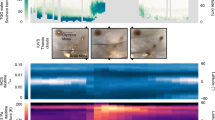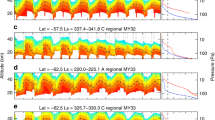Abstract
Present-day water loss from Mars provides insight into Mars’s past habitability1,2,3. Its main mechanism is thought to be Jeans escape of a steady hydrogen reservoir sourced from odd-oxygen reactions with near-surface water vapour2, 4,5. The observed escape rate, however, is strongly variable and correlates poorly with solar extreme-ultraviolet radiation flux6,7,8, which was predicted to modulate escape9. This variability has recently been attributed to hydrogen sourced from photolysed middle atmospheric water vapour10, whose vertical and seasonal distribution is only partly characterized and understood11,12,13. Here, we report multi-annual observational estimates of water content and dust and water transport to the middle atmosphere from Mars Climate Sounder data. We provide strong evidence that the transport of water vapour and ice to the middle atmosphere by deep convection in Martian dust storms can enhance hydrogen escape. Planet-encircling dust storms can raise the effective hygropause (where water content rapidly decreases to effectively zero) from 50 to 80 km above the areoid (the reference equipotential surface). Smaller dust storms contribute to an annual mode in water content at 40−50 km that may explain seasonal variability in escape. Our results imply that Martian atmospheric chemistry and evolution can be strongly affected by the meteorology of the lower and middle atmosphere of Mars.
This is a preview of subscription content, access via your institution
Access options
Access Nature and 54 other Nature Portfolio journals
Get Nature+, our best-value online-access subscription
$29.99 / 30 days
cancel any time
Subscribe to this journal
Receive 12 digital issues and online access to articles
$119.00 per year
only $9.92 per issue
Buy this article
- Purchase on Springer Link
- Instant access to full article PDF
Prices may be subject to local taxes which are calculated during checkout




Similar content being viewed by others
References
Carr, M. H. & Head, J. W. III Oceans on Mars: an assessment of the observational evidence and possible fate. J. Geophys. Res. 108, 5042 (2003).
Zahnle, K., Haberle, R. M., Catling, D. C. & Kasting, J. F. Photochemical instability of the ancient Martian atmosphere. J. Geophys. Res. 113, E11004 (2008).
Villanueva, G. L. et al. Strong water isotopic anomalies in the Martian atmosphere: probing current and ancient reservoirs. Science 348, 218–221 (2015).
McElroy, M. B., Kong, T. Y. & Yung, Y. L. Photochemistry and evolution of Mars’ atmosphere: a Viking perspective. J. Geophys. Res. 82, 4379–4388 (1977).
Lewis, J. S. Physics and Chemistry of the Solar System 2nd edn (Academic Press, Cambridge, MA, 2004).
Clarke, J. T. et al. A rapid decrease of the hydrogen corona of Mars. Geophys. Res. Lett. 41, 8013–8020 (2014).
Bhattacharya, D., Clarke, J. T., Bertaux, J.-L., Chaufray, J.-Y. & Mayyasi, M. A strong seasonal dependence in the Martian hydrogen exosphere. Geophys. Res. Lett. 42, 8678–8685 (2015).
Chaffin, M. S. et al. Unexpected variability of Martian hydrogen escape. Geophys Res. Lett. 41, 314–320 (2014).
Chaufray, J.-Y. et al. Variability of the hydrogen in the Martian atmosphere as simulated by a 3D atmosphere–exosphere coupling. Icarus 245, 282–294 (2015).
Chaffin, M. S., Deighan, J., Schneider, N. M. & Stewart, A. I. F. Elevated atmospheric escape of hydrogen from Mars induced by high-altitude water. Nat. Geosci. 10, 174–178 (2017).
Maltagliati, L. et al. Annual survey of water vapor vertical distribution and water–aerosol coupling in the Martian atmosphere observed by SPICAM/MEx solar occultations. Icarus 223, 942–962 (2013).
Clancy, R. T. et al. Vertical profiles of Mars 1.27 μm O2 dayglow from MRO CRISM limb spectra: seasonal/global behaviors, comparisons to LMD GCM simulations, and a global definition for Mars water vapor profiles. Icarus 293, 132–156 (2017).
Montmessin, F. et al. SPICAM on Mars Express: a 10 year in-depth survey of the Martian atmosphere. Icarus 297, 195–216 (2017).
Kleinböhl., A. et al. Mars Climate Sounder limb profile retrieval of atmospheric temperature, pressure, and dust and water opacity. J. Geophys. Res. 114, E10006 (2009).
Toigo, A. D., Smith, M. D., Seelos, F. P. & Murchie, S. L. J. Geophys. Res. Planets 118, 89–104 (2013).
Halekas, J. S. Seasonal variability of the hydrogen exosphere of Mars. J. Geophys. Res. Planets 122, 901–911 (2017).
Clancy, R. T. et al. An intercomparison of ground-based millimeter, MGS TES, and Viking atmospheric temperature measurements: seasonal and interannual variability of temperatures and dust loading in the global Mars atmosphere. J. Geophys. Res. 105, 9553–9571 (2000).
Piqueux, S., Byrne, S., Titus, T., Hansen, C. & Kieffer, H. Enumeration of Mars years and seasons since the beginning of telescopic exploration. Icarus 251, 164–180 (2014).
Wang, H. & Richardson, M. I. The origin, evolution, and trajectory of large dust storms on Mars during Mars years 24–30 (1999–2011). Icarus 251, 112–127 (2015).
Fedorova, A. et al. Water vapor in the middle atmosphere of Mars during the 2007 global dust storm. Icarus 300, 440–457 (2018).
Montmessin, F., Forget, F., Rannou, P., Cabane, M. & Haberle, R. M. Origin and role of water ice clouds in the Martian water cycle as inferred from a general circulation model. J. Geophys. Res. Planets 109, E10004 (2004).
Cantor, B., Malin, M. & Edgett, K. S. Multiyear Mars Orbiter Camera (MOC) observations of repeated Martian weather phenomena during the northern summer season. J. Geophys. Res. 107, 5014 (2002).
Rafkin, S. C. R., Maria, M. R. V. S. & Michaels, T. I. Simulation of the atmospheric thermal circulation of a Martian volcano using a mesoscale numerical model. Nature 419, 697–699 (2002).
Heavens, N. G. et al. Extreme detached dust layers near Martian volcanoes: evidence for dust transport by mesoscale circulations forced by high topography. Geophys. Res. Lett. 42, 3730–3738 (2015).
Head, J. W. et al. Tropical to mid-latitude snow and ice accumulation, flow and glaciation on Mars. Nature 434, 346–351 (2005).
Mischna, M. A. & Richardson, M. I. A reanalysis of water abundances in the Martian atmosphere at high obliquity. Geophys. Res. Lett. 32, L03201 (2005).
Newman, C. E., Lewis, S. R. & Read, P. L. The atmospheric circulation and dust activity in different orbital epochs on Mars. Icarus 174, 135–160 (2005).
Bougher, S. W. et al. The structure and variability of Mars dayside thermosphere from MAVEN NGIMS and IUVS measurements: seasonal and solar activity trends in scale heights and temperatures. J. Geophys. Res. Space Phys. 122, 1296–1313 (2017).
Chaffin, M. S. et al. Three-dimensional structure in the Mars H corona revealed by IUVS on MAVEN. Geophys. Res. Lett. 42, 9001–9008 (2015).
Kleinböhl, A., Friedson, A. J. & Schofield, J. T. Two-dimensional radiative transfer for the retrieval of limb emission measurements in the Martian atmosphere. J. Quant. Spectrosc. Radiat. Transfer 187, 511–522 (2017).
Heavens, N. G. et al The vertical distribution of dust in the Martian atmosphere during northern spring and summer: observations by the Mars Climate Sounder and analysis of zonal average vertical dust profiles. J. Geophys. Res. 116, E04003 (2011).
Zurek, R. W. & Smrekar, S. E. An overview of the Mars Reconnaissance Orbiter (MRO) science mission. J. Geophys. Res. 112, E05S01 (2007).
Murphy, D. M. & Koop, T. Review of the vapour pressures of ice and supercooled water for atmospheric applications. Q. J. R. Meteor. Soc. 131, 1359–1365 (2005).
McCleese, D. J. et al. Structure and dynamics of the Martian lower and middle atmosphere as observed by the Mars Climate Sounder: seasonal variations in zonal mean temperature, dust, and water ice aerosols. J. Geophys Res. 115, E12016 (2010).
Conrath, B. J. Thermal structure of the Martian atmosphere during the dissipation of the dust storm of 1971. Icarus 24, 36–46 (1975).
Heavens, N. G. et al Seasonal and diurnal variability of detached dust layers in the tropical Martian atmosphere. J. Geophys. Res. Planets 119, 1748–1774 (2014).
Boxe, C. S. et al. Adsorbed water and thin liquid films on Mars. Int. J. Astrobiol. 11, 169–175 (2012).
Malin, M. C., Cantor, B. A. & Britton, A. W. MRO MARCI Weekly Weather Reports (2007–2017); http://www.msss.com/msss_images/subject/weather_reports.html
Kass, D. M., Kleinböhl, A., McCleese, D. J., Schofield, J. T. & Smith, M. D. Interannual similarity in the Martian atmosphere during the dust storm season. Geophys. Res. Lett. 43, 6111–6118 (2016).
Acknowledgements
This work was supported by NASA’s Mars Data Analysis and Nexus for Exoplanet System Science programmes (NNX14AM32G and NNX15AE05G to N.G.H. and NNN13D465T to A.K.). Work at the Jet Propulsion Laboratory, California Institute of Technology is performed under contract with NASA. The authors thank A. D. Toigo for providing CRISM data.
Author information
Authors and Affiliations
Contributions
N.G.H. and A.K. conceived and designed the study with input from M.S.C. N.G.H. designed and analysed the dust and water vapour flux diagnoses and analysed the inferred water vapour information. A.K. designed the inferred water vapour diagnosis. J.S.H. processed and interpreted hydrogen corona observations from MAVEN. All authors assisted N.G.H. with the preparation of the manuscript.
Corresponding author
Ethics declarations
Competing interests
The authors declare no competing financial interests.
Additional information
Publisher’s note: Springer Nature remains neutral with regard to jurisdictional claims in published maps and institutional affiliations.
Supplementary information
Supplementary Information
Supplementary Table 1, Supplementary Figures 1–4.
Rights and permissions
About this article
Cite this article
Heavens, N.G., Kleinböhl, A., Chaffin, M.S. et al. Hydrogen escape from Mars enhanced by deep convection in dust storms. Nat Astron 2, 126–132 (2018). https://doi.org/10.1038/s41550-017-0353-4
Received:
Accepted:
Published:
Issue Date:
DOI: https://doi.org/10.1038/s41550-017-0353-4
This article is cited by
-
Coupling and interactions across the Martian whole atmosphere system
Nature Geoscience (2023)
-
Alternate oscillations of Martian hydrogen and oxygen upper atmospheres during a major dust storm
Nature Communications (2022)
-
Martian moons exploration MMX: sample return mission to Phobos elucidating formation processes of habitable planets
Earth, Planets and Space (2022)
-
The Mars system revealed by the Martian Moons eXploration mission
Earth, Planets and Space (2022)
-
Mars’ plasma system. Scientific potential of coordinated multipoint missions: “The next generation”
Experimental Astronomy (2022)



